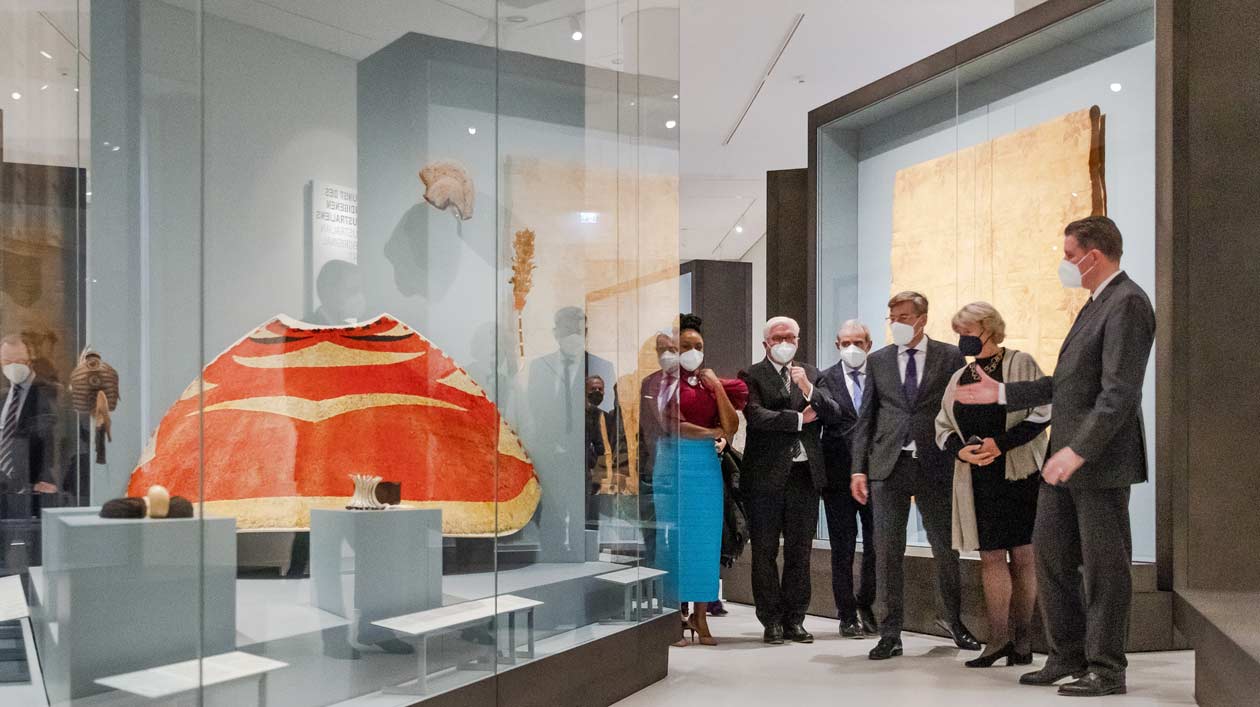Worlds in the West Wing: Staatliche Museen open in the Humboldt Forum
News from 09/22/2021
After years spent moving the collections of the Ethnologisches Museum and the Museum für Asiatische Kunst, they are finally on show in the heart of Berlin, with an additional focus on their colonial contexts.

Together with Federal President Frank-Walter Steinmeier, Minister of State for Culture Monika Grütters opened the presentations of the Ethnologisches Museum (Ethnological Museum) and the Museum für Asiatische Kunst (Asian Art Museum) in the Humboldt Forum at a ceremony on 22 September 2021. In her address to the guests, writer Chimamanda Ngozi Adichie said: "We cannot change the past, but we can change people's blindness to the past."
The two museums' new presentations of their collections on the second and third floors of the west wing will be open to visitors from 23 September onward. With more than 8,500 square meters of floor area and over thirty exhibition modules, they will show some 10,000 exhibits and illuminate them from different perspectives. With the collections of objects from Africa, Asia, Oceania, and America in the Humboldt Forum and those relating to the art and cultural history of Europe and the Middle East on Museumsinsel (Museum Island), the center of Berlin has truly become a forum for the world's cultures.
The exhibitions also incorporate contemporary artistic interventions that relate directly to the collections or have been created in response to them, such as the large installation Township Wall by António Ole and a dress designed as a work of art by fashion artist Cynthia Schimming. There are also spectacular interiors, such as the elliptical listening room for ethnomusicology and the hall designed by Pritzker Prize winner Wang Shu for the Museum für Asiatische Kunst.
The collections and the objects on display are presented and commented on from a variety of viewpoints. From the beginning, the curators sought to achieve and implement a multi-perspectival view. This meant that cooperation with partners in other countries and with members of source communities was an integral part of the exhibition concept.
But the museums are not only presenting ongoing, cooperative research into the objects and using new exhibition and education concepts; they are also addressing the history of their own collection as well as current post-colonial topics. The critical assessment of an object’s provenance and the context of its acquisition, and of its entrenchment in colonial history, are all part of the narrative in the Humboldt Forum and they will continue to shape the work done on our collections.
The aim of the exhibition in the Humboldt Forum is to juxtapose multiple perspectives on the objects and their stories in ways that are both visible and audible, and to make the experience as participatory and inclusive as possible. Communication therefore plays a major part in the design of the two museums' new presentations; for example, the consistent use of graphics and digital media as well as clearly designated areas for families, children, and young people.
The architecture of the permanent exhibition, conceived and designed by Ralph Appelbaum Associates in collaboration with the curators, was required to be as flexible and portable as possible. This has been achieved by using a modular system. It allows, on the one hand, for spacious, lofty halls with weighty, large objects. On the other, it can be used to create classic object-centered exhibition areas furnished with showcases and plinths, as in the sections on "Sacred Art in China and Japan" and the "Art of Buddhism in South Asia."
In addition, both museums offer the visitor access to open storage areas and study collections. The contents are organized along thematic lines in an environment with the feel of a museum storage depot, created by presenting the objects at a high density in large showcase structures. These sections underline the importance of collections as the basis of every museum, the resource from which exhibitions and other projects can be created in ever new and changing ways. Here too, the presentation does not omit to consider the history of the collection itself and the ways in which it was collected – and thus the provenance of the exhibits.

